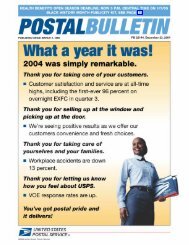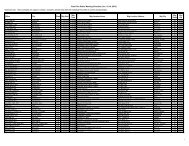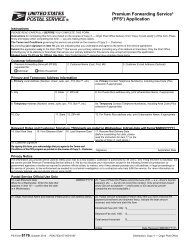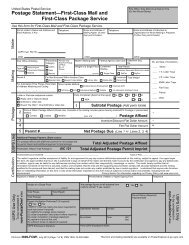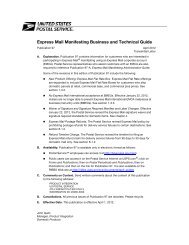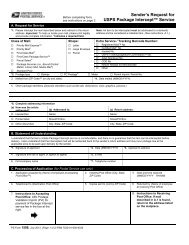2010 Comprehensive Statement on Postal Operations - USPS.com
2010 Comprehensive Statement on Postal Operations - USPS.com
2010 Comprehensive Statement on Postal Operations - USPS.com
You also want an ePaper? Increase the reach of your titles
YUMPU automatically turns print PDFs into web optimized ePapers that Google loves.
Chapter 3: Operati<strong>on</strong>s<br />
FSS can sequence flat mail at a rate of up to 16,500 pieces per hour.<br />
All major FSS preparati<strong>on</strong> milest<strong>on</strong>es are closely m<strong>on</strong>itored to<br />
ensure successful implementati<strong>on</strong>. Area and District coordinators<br />
have been established at all sites, and <strong>com</strong>prehensive hands-<strong>on</strong><br />
training and seminars were provided to hundreds of key pers<strong>on</strong>nel.<br />
Online resources are also available for c<strong>on</strong>tinuous field training and<br />
support. Maintenance training and support c<strong>on</strong>tinues at two FSS<br />
units installed at the Nati<strong>on</strong>al Center for Employee Development in<br />
Norman, OK.<br />
OTHER FLATS AUTOMATION<br />
Address recogniti<strong>on</strong> rates for flats processed <strong>on</strong> the Automated Flat<br />
Sorting Machine 100 c<strong>on</strong>tinue to improve under Phase 2 of Flat<br />
Recogniti<strong>on</strong> Improvement. Hardware and software upgrades this year<br />
saved $7.3 milli<strong>on</strong> by increasing address read rates and reducing<br />
sortati<strong>on</strong> errors.<br />
LETTER AUTOMATION<br />
Letter processing equipment is being upgraded to take full<br />
advantage of the IM barcode and other technology developments.<br />
In <str<strong>on</strong>g>2010</str<strong>on</strong>g>, the <strong>Postal</strong> Service began to deploy the Advanced<br />
Facer Canceller System (AFCS) 200 system to replace older<br />
letter cancellati<strong>on</strong> equipment. AFCS 200 significantly improves<br />
performance by reducing handling in downstream operati<strong>on</strong>s.<br />
Deployment of 550 systems will be <strong>com</strong>pleted in 2011.<br />
Phase 2 of Distributi<strong>on</strong> Quality Improvement (DQI) is improving<br />
recogniti<strong>on</strong> of handwritten and machine-printed addresses <strong>on</strong><br />
letters by incorporating informati<strong>on</strong> from <strong>com</strong>mercial databases, an<br />
enhancement that will save $30 milli<strong>on</strong> annually by keeping more<br />
letters in the automated mailstream. Other new software releases for<br />
automated letter systems have dramatically reduced the amount of<br />
mail rejected because of missing data or unreadable images.<br />
In June, the <strong>Postal</strong> Service began deploying 195 Low-Cost Reject<br />
Encoding Machines, which are being built from excess carrier<br />
sequence barcode sorters. The new equipment covers unreadable<br />
barcodes with a label, interprets the mailing address, and applies the<br />
correct barcode.<br />
PARCEL AND BUNDLE AUTOMATION<br />
Deployment of the sort accuracy improvement program for the<br />
Automated Package Processing System (APPS) was <strong>com</strong>pleted in<br />
November 2009. This enhancement reduces distributi<strong>on</strong> errors and<br />
improves system efficiency. A laser sensor/camera was also added<br />
to APPS to quickly detect and reduce errors.<br />
A new effort is underway to extend the service life of aging Small<br />
Parcel and Bundle Sorters (SPBS) that will still be needed at sites<br />
without APPS. Plans are to replace SPBS c<strong>on</strong>trol systems, add<br />
barcode and optical character reader technology, and improve<br />
inducti<strong>on</strong> stati<strong>on</strong>s. The upgraded equipment will be renamed the<br />
Automated Parcel and Bundle Sorter (APBS). Successful tests of the<br />
prototype were c<strong>on</strong>ducted in April in Louisville, KY. Early deployment<br />
of 10 APBS is planned by November <str<strong>on</strong>g>2010</str<strong>on</strong>g>, followed by deployment<br />
of producti<strong>on</strong> systems starting in June 2011.<br />
POSTAL AUTOMATED REDIRECTION SYSTEM<br />
The <strong>Postal</strong> Automated Redirecti<strong>on</strong> System (PARS) redirects<br />
forwardable letter mail during processing, a significant advance<br />
over legacy systems that required transport of such mail to a<br />
centralized forwarding system (CFS) unit. Initial PARS deployment<br />
to 283 processing facilities was <strong>com</strong>pleted in 2007. As PARS<br />
technology has improved, additi<strong>on</strong>al CFS sites have been<br />
c<strong>on</strong>solidated, including 26 in <str<strong>on</strong>g>2010</str<strong>on</strong>g>. The volume of mail processed<br />
each year <strong>on</strong> PARS now stands at more than 3.4 billi<strong>on</strong> pieces.<br />
Fewer than 40 milli<strong>on</strong> pieces are currently processed through<br />
CFS units.<br />
New PARS software permits real-time updates to nati<strong>on</strong>al change-ofaddress<br />
listings. Other enhancements allow printing of new address<br />
labels at delivery units rather than at CFS sites, an improvement<br />
projected to save $2 milli<strong>on</strong> annually. This effort is nearly <strong>com</strong>pleted<br />
nati<strong>on</strong>wide, with full deployment expected by December <str<strong>on</strong>g>2010</str<strong>on</strong>g>.<br />
INTEGRATED DATA SYSTEM AND NATIONAL DIRECTORY<br />
SUPPORT SYSTEM<br />
The <strong>Postal</strong> Service deployed Integrated Data System–Nati<strong>on</strong>al<br />
Directory Support System (IDS-NDSS) hardware this year to replace<br />
existing end-of-life hardware at NDCs and processing plants.<br />
IDS provides the critical infrastructure for managing distributi<strong>on</strong><br />
operati<strong>on</strong>s, equipment performance, and critical maintenance within<br />
a facility. It c<strong>on</strong>solidates mail and c<strong>on</strong>tainer data from all automated<br />
equipment systems and distributes it for use by multiple applicati<strong>on</strong>s.<br />
NDSS maintains the distributi<strong>on</strong> sort programs and address directory<br />
files that underlie automated mail processing.<br />
MAIL HISTORY TRACKING SYSTEM<br />
The Mail History Tracking System (MHTS) is an applicati<strong>on</strong> that uses<br />
barcode data to track mailpieces from origin (cancellati<strong>on</strong>) to Delivery<br />
Point Sequencing processing. The applicati<strong>on</strong> can assess if individual<br />
mailpieces are likely to meet <strong>on</strong>-time targets and helps identify<br />
<str<strong>on</strong>g>2010</str<strong>on</strong>g> <str<strong>on</strong>g>Comprehensive</str<strong>on</strong>g> <str<strong>on</strong>g>Statement</str<strong>on</strong>g> <strong>on</strong> <strong>Postal</strong> Operati<strong>on</strong>s | 27




